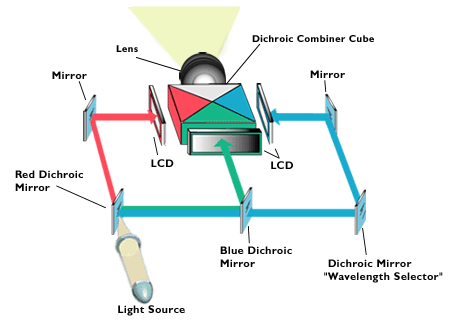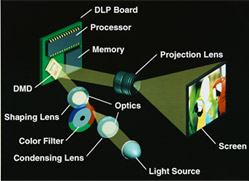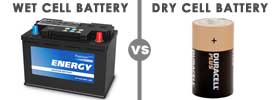Difference between DLP and LCD Projectors
Key Difference: LCDs work using liquid crystals placed between two polarizing filters and two transparent electrodes. DLP uses a series of mirrors placed on a chip, which work as pixels. LCDs are skinnier, consume more power and has a better viewing angle compared to DLP. Whereas, DLPs are cheaper, have a wider color gamut and have a longer lifespan. LCD’s can suffer from burn-in, while DLPs suffer from a “rainbow effect”.

Digital Light Processing (DLP) and Liquid Crystal Display (LCD) are two types of display technologies that are used in projectors. Almost all projectors today use either one of these technologies, and they can also be found in TVs and computer monitors.
LCDs work using liquid crystals placed between two polarizing filters and two transparent electrodes. When a current passes through, the liquid crystals act as pixels, either blocking the light or allowing it to pass through. Liquid crystals do not emit their own light and hence require an external lighting system. In an LCD projector light is sent from a metal-halide lamp through a prism and a series of filters to three different glass panels (one red, one blue and one green), which decides if the light is allowed or blocked.
On the other hand, DLP uses a series of mirrors placed on a chip, which work as pixels. DLP is developed by Texas Instrument in 1987. The DLP chip comprises around 2 million hinge-mounted microscopic mirrors and is combined with a digital video or graphic signal, a light source, a projection lens, and a color filter. In order to create an image, the DLP chip mounted with the mirrors is either tilted towards the light source (ON) or away from it (OFF). The rapid tilting creates a light or dark pixel on the surface and the color is added using a color wheel. This technology is most commonly used in digital cinema projection.
Performance wise there are a few differences between the two, LCDs are skinnier, consume more power and has a better viewing angle compared to DLP. Whereas, DLPs are cheaper, have a wider color gamut and have a longer lifespan. LCD’s can suffer from

burn-in, while DLPs suffer from a “rainbow effect”. The rainbow effect is when a color streak is caused across the screen when a person looks away from the screen and then looks back swiftly. This is due to the spinning color wheel and is eliminated with the use of the three-chip projectors.
|
|
LCD |
DLP |
|
Thickness |
Skinner compared to DLP |
Thicker compared to LCD |
|
Power consumption |
Consumes more power compared to DLP |
Consumes less power as mirrors do not need extra powering |
|
Screen Refresh Rate |
Less than LED |
Higher than LCD |
|
Screen glare |
Glare is minimum |
Glare is minimum |
|
Running Temperature |
Hotter compared to DLP |
Cooler |
|
Burn-in |
No burn-in occurs; but burn-outs can occur |
No burn-ins can occur |
|
Dead pixels |
Can occur |
Are very rare |
|
Viewing angle |
Up to 165 degrees |
Less than 40 degrees |
|
Contrast Ratio |
15000:1 |
2000:1 or higher |
|
Life span |
60,000 hours |
80,000 hours |
|
Black level |
Gray to Dark Gray |
Dark Gray to Gray |
|
Weight |
Lighter compared to DLP |
Heavier compared to LCD |
|
Uses |
Computer monitors, laptop screens, TV screens and cell phone screens |
Projectors, TV screens |
|
Price |
Expensive compared to DLP |
Cheaper compared to LCD |
|
Benefits |
Panels weigh less than plasma; use less energy; light; thinner; emits less electromagnetic radiation; no bleeding or smearing |
Smooth jitter-free images; Perfect geometry and excellent grayscale linearity achievable; no screen burn-in; Less "screen-door effect" than with LCD projectors; offers affordable 3D projection display; longer lifespan; wider color gamut |
|
Limitations |
Slower refresh rate; limited viewing angle; blacks are brighter; susceptible to burn-out and image persistence; dead or stuck pixels may appear; smearing or ghosting can appear; loss of contrast in higher temperatures; poor display in sunlight |
Rainbow effect; thicker; replacement lamp/light bulbs are expensive; dithering noise; error-diffusion artifacts; lag in gaming response times; reduced viewing angle; may use more electricity |
Image Courtesy: ustudy.in, dlp.com









Add new comment